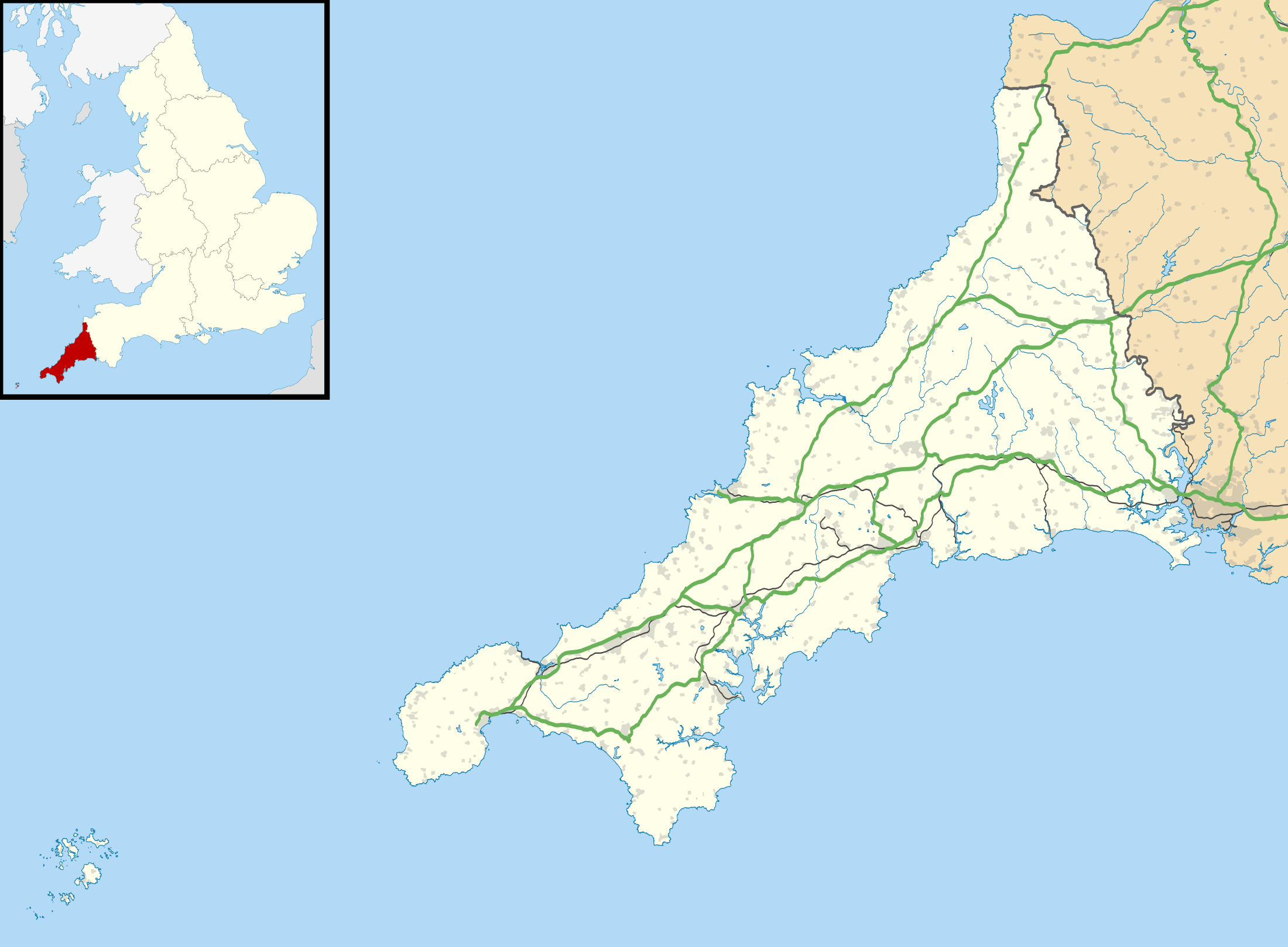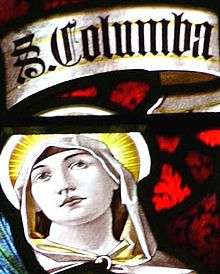St Columba's Church, St Columb Major
St Columba's Church is a 14th-century, Grade I listed parish church in the Church of England Diocese of Truro in St Columb Major, Cornwall.[2] In 1860 plans were drawn up by William Butterfield, in hope of St Columb church becoming the cathedral of the future diocese of Cornwall, but the cathedral was built at Truro.[3] A second church dedicated to the same saint is known as St Columba's Church, St Columb Minor
| Church of Saint Columba | |
|---|---|
 | |
 Church of Saint Columba Location within Cornwall | |
| 50°26′08.5″N 04°56′25.1″W | |
| Location | St Columb Major |
| Country | England |
| Denomination | Church of England |
| Website | Lannpydar.org.uk |
| History | |
| Dedication | Saint Columba the Virgin |
| Architecture | |
| Heritage designation | Grade I listed[1] |
| Designated | 1967 |
| Specifications | |
| Spire height | 80 feet (24 m) |
| Materials | Slatestone rubble with granite dressings |
| Bells | 8 |
| Administration | |
| Parish | St Columb Major |
| Deanery | Pydar |
| Diocese | Truro |
| Province | Canterbury |
| Clergy | |
| Rector | Revd. Helen Baber |
| Curate(s) | Revd. Tess Lowe |
| Minister(s) | Phil Tremain |
| Laity | |
| Organist(s) | Keith Rusling |
| Churchwarden(s) | Colin Rescorla |
History
The current church dates from the 13th to 15th centuries. The font is Norman and there are many good examples of woodcarving in the church: these include the bench ends dated 1510, the rood screen, wagon roofs, and a 19th-century carved wooden pulpit.
In 1676 three youths set fire to a barrel of gunpowder, killing themselves and causing £350 worth of damage to the church. Through public donations and a small parish rate the church was repaired within nine months.[4]
Parish status
The church is in the Lann Pydar[5] joint benefice with:
Organ
The organ dates from 1870 and was built by Bryceson & Ellis of Lincoln. A specification of the organ can be found in the National Pipe Organ Register.[6]
Font
The octagonal stone font in south aisle, of circa 1300 with carved sides, including five men's faces, on stem with clustered outer shafts.[7]
Bells
According to the National Bell register,[8] there are eight bells dating from 1776 to 1950. The earliest bells are by J C & W Pennington of Exeter. (1776). The later ones are by John Taylor & Co, (1950 & 1969). One bell from 1825 is by John Rudhall. The bells were overhauled in 1950 by Loughborough Bellfoundry. The heaviest of the bells is the tenor, which weighs 1404lb or 637kg.[9]
Memorials
Some of the more interesting items are some fine monumental brasses and memorials, including:
- Sir John Arundell (1474–1545), KB, of Lanherne, St. Mawgan-in-Pyder, Cornwall, "the most important man in the county", Receiver-General of the Duchy of Cornwall,[10] perhaps not buried here. His brass was described by Dunkin (1882) as "perhaps the most elaborate and interesting brass to be found in Cornwall"[11]
- Eleanor Grey wife of the above John Arundell. She was granddaughter of Elizabeth Woodville, who was Queen consort of England as the spouse of King Edward IV
- Sir John Arundell, 1591, and his wife (died 1602, brass engraved 1635)
- John Arundell and his wife, 1633 (on the same stone).[12]
- Robert Hoblyn was a Member of Parliament for Bristol who died at Nanswhyden House on 17 November 1756. His monument in St Columb Church bears a long inscription. [13]
- Sir Richard Bellings (1622 – 30 October 1716) was an Irish courtier who served as the Knight secretary to Catherine of Braganza, the wife of King Charles II.[14]
War memorial
The granite war memorial, erected in 1920, was designed to represent a classic Cornish cross. It names 55 men connected to the parish who lost their lives in the first and second world wars
Other features

There is a fine wooden screen by the architect George Fellowes Prynne "St Columb screen". and some exceptional oak benchends, dating as far back as 1510. The fine organ is by Bryceston Bros. & Ellis of London and a copy of the "Letter of Thanks" to the Cornish people sent by Charles I in 1643 (similar copies are found in many Cornish churches). There are also two sculptures by the artist Allan G. Wyon and a stained glass window portraying St Columba the Virgin. In the churchyard is St Columba's Cross.
References
- Historic England. "Church of St Columba (Grade I) (1144068)". National Heritage List for England. Retrieved 12 May 2019.
- Beacham, Peter; Pevsner, Nikolaus (2014). The Buildings of England. Cornwall. Yale University Press. p. 55. ISBN 9780300126686.
- "The Gentleman's Magazine 1860, p. 147". Retrieved 12 May 2019.
- Gilbert, Davies (1838). The Parochial History of Cornwall, Founded on the Manuscript Histories of Mr Hals and Mr Tonkin; with additions and various appendices. London: J B Nichols and Son. pp. 215–216.
- The Lann Pydar Benefice, Cornwall http://www.lannpydar.org.uk/index.html. Retrieved 13 May 2019. Missing or empty
|title=(help) - "NPOR K01270". National Pipe Organ Register. British Institute of Organ Studies. Retrieved 11 May 2019.
- Historic England. "Details from listed building database (1144068)". National Heritage List for England. Retrieved 14 May 2019.
- "A National Bell Register". Retrieved 14 May 2019.
- Doves Guide for Church Bell Ringers https://dove.cccbr.org.uk/detail.php?searchString=st+columb&Submit=+Go+&DoveID=SAI+COLUMA. Retrieved 14 May 2019. Missing or empty
|title=(help) - Byrne, Muriel St. Clare, (ed.) The Lisle Letters, 6 vols, University of Chicago Press, Chicago & London, 1981, vol.1, p.307
- Dunkin, E. H. W. The Monumental Brasses of Cornwall, 1882
- Dunkin, E. (1882) The Monumental Brasses of Cornwall. London, Spottiswoode; pp. 27–31, 75–82, pl. XXVII, LVI, LVII
- "Monument to Robert Hoblyn". Royal Society. Retrieved 20 March 2019.
- The Role of Anti-Catholicism in England in the 1670s
External links
| Wikimedia Commons has media related to St. Columb's church, St Columb Major. |